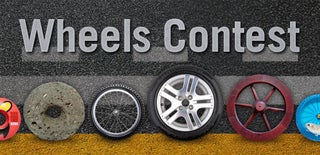Introduction: DIY Bike Tachometer
I will show you how to build a bike speedometer. It shows your speed,
the average speed,the temperature, the trip time and the total distance. You can change it using the button. Additionally, the speed is shown on a tachometer. I built it because I like building new things, I have not found anything like this on the internet so I want to show you how to build a good speedometer as the one on my bike is not as cool as I want :) . So let's get started.
Step 1: Parts:
This is a list of parts that you will need. They costed me about $ 40:
- Arduino
- Bike with reed switch
- LCD display 16x2
- Servo
- Breadboard
- Thermometer DS18B20
- Resistor 1.2k Ω , 4.7k Ω
- Switch
- Button
- Potentiometer 10 kΩ
- 9V battery
- Cables
- Box
- Tools (drill, soldering, knife, tape)
Step 2: Connection
I added a picture from Fritzing and verbal description of how to connect it. In the picture all red wires are connected to 5V, all blue cables are connected to GND.
- LCD display:
VSS --> GND Arduino
VDP --> 5V Arduino
VO --> output potentiometer (potentiometer VCC -> 5V Arduino, potentiometer GND -> Arduino GND).
RS --> pin 12 Arduino
RW --> GND Arduino
E --> pin 11 Arduino
D4 --> pin 5 Arduino
D5 --> pin 4 Arduino
D6 --> pin 3 Arduino
D7 --> pin 2 Arduino
A --> 5V Arduino
K --> GND Arduino
- Servo:
VCC --> 5V Arduino
mass --> GND Arduino
Data --> pin 6 Arduino
- Thermometer:
VCC --> 5V Arduino
mass --> GND Arduino
Data --> pin 1 Arduino
data and power is connected via a 4.7 kΩresistor
- Sensor on wheel:
one end -> 5V Arduino
second end -> A0 Arduino and resistor 1,2 kΩ
The other end of the resistor to ground in the Arduino
- Button:
one end --> 5V Arduino
second end --> A1 Arduino
Step 3: Upload Code:
Below I added the code in comments there is an explanation.
links to the download libraries:
http://www.pjrc.com/teensy/arduino_libraries/OneWire.zip
https://github.com/milesburton/Arduino-Temperature-Control-Library
If you have a different wheel diameter you have to change it. You can calculate it with this formula:
circuit = π*d*2,54 (d=diameter of your wheel, I multiplied it by 2.54 to get the result in meters).
/*
##################################################
Copyright by Nikodem Bartnik june 2014
##################################################
*/
//librarys
#include < Servo.h>
#include <LiquidCrystal.h>
#include <OneWire.h>
#include <DallasTemperature.h>
#define ONE_WIRE_BUS 1
OneWire oneWire(ONE_WIRE_BUS);
DallasTemperature sensors(&oneWire);
//LCD display pins
LiquidCrystal lcd(12, 11, 5, 4, 3, 2);
//servo name
Servo myservo;
//definition of variables
long previous, triptime, time, impulses;
float speedometer, dist, aspeed;
int servo;
int screen=1;
//If you have other circuit of wheel you need change it
float circuit=2.0;
double temperature;
void setup() {
lcd.begin(16, 2);</p><p>
pinMode(A0, INPUT);
pinMode(A1, INPUT);
//servo definition and setting the tachometer to 0
myservo.attach(6);
myservo.write(180);
lcd.print("Bike tachometer");
delay(1000);
lcd.setCursor(5, 1);
lcd.print("V 1.0");
delay(4000);
lcd.clear();
delay(500);
lcd.setCursor(0, 0);
lcd.print("Dist:");
}
void loop() {
//if wheel turns
if(analogRead(A0)>=300){
//number of turns++
impulses++;
//count turn time
time=(millis()-previous);
//count speed
speedometer=(circuit / time)*3600.0;
previous=millis();
Tachometer();
delay(100);
}
Lcd();
}
//display speed on tachometer
void Tachometer(){
//map speed 0-180 to servo
speedometer=int(speedometer);
servo = map(speedometer, 0, 72, 180, 0);
//setup servo
myservo.write(servo);
}
void Lcd(){
//when button is clicked
if(analogRead(A1)>=1010){
lcd.clear();
screen++;
if(screen==5){
screen=1;
}
}
if(screen==1){
//displays speed
lcd.setCursor(0, 1);
lcd.print("Speed:");
lcd.setCursor(7, 1);
lcd.print(speedometer);
lcd.print("km/h");
}
if(screen==2){
//displays themperature
temperature=sensors.getTempCByIndex(0);
sensors.requestTemperatures();
lcd.setCursor(0, 1);
lcd.print("Temp:");
lcd.setCursor(7, 1);
lcd.print(temperature);
lcd.print(" C");
}
if(screen==3){
//displays averagr speed
aspeed=dist/(millis()/1000.0)*3600.0;
lcd.setCursor(0, 1);
lcd.print("A.speed:");
lcd.setCursor(8, 1);
lcd.print(aspeed);
lcd.print("km/h");
}
if(screen== 4){
//diplays trip time
triptime=millis()/60000;
lcd.setCursor(0, 1);
lcd.print("Time:");
lcd.setCursor(7, 1);
lcd.print(triptime);
}
lcd.setCursor(0, 0);
lcd.print("Dist:");
//calculation of the distance
dist=impulses*circuit/1000.00;
//dislays distance
lcd.setCursor(6,0);
lcd.print(dist);
lcd.print("km");
}
Attachments
Step 4: Pack
As a cover I used a plastic box I bought for $ 1. I cut holes using a knife and a drill. Servo and LCD display I glued with a tape, tip I made with carton and painted it with paint. I did shield in Corel Draw X5 and I printed it, I added a PNG image, and Corel Draw file (if you want, you can edit it). I clipped the box to steering wheel on my bike and I soldered cables to the reed switch.
Attachments
Step 5: Run It!
Now it is ready. All you need to do is turn it on and ride. Have fun with your speedometer. If you like this project, please vote on me.

Participated in the
Battery Powered Contest

Participated in the
Wheels Contest














